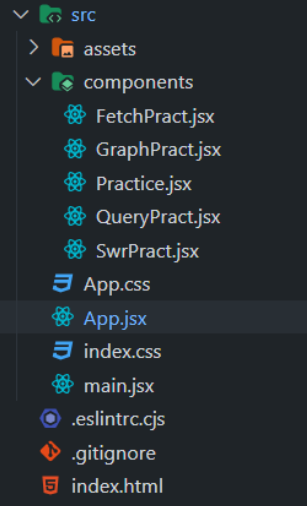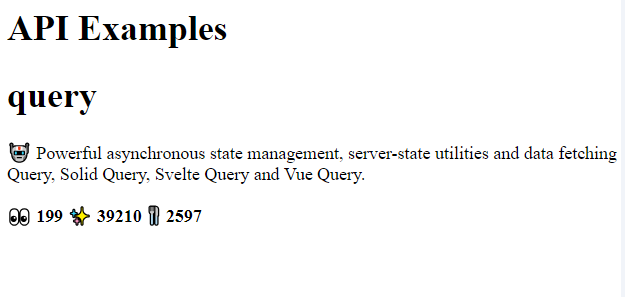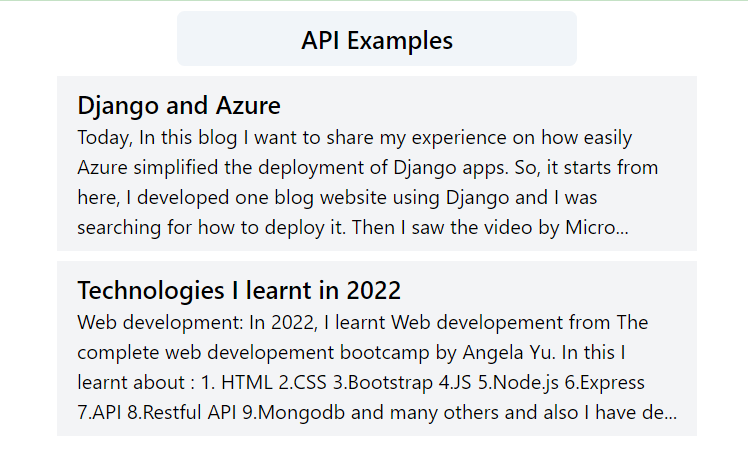Data fetching libraries like React Query and React Hooks simplify how developers fetch and manage data in React applications. These tools provide easy-to-use functions like 'useQuery' and 'SWR' that streamline API interactions and state management, improving code readability and reducing boilerplate.
By using the below libraries, we can create more efficient and responsive user interfaces while handling asynchronous data operations with ease.
Prerequisites:
Steps to Setup the React Project
Step 1: Create a reactJS application by using this command
npx create-react-app my-appStep 2: Navigate to the project directory
cd marketplaceStep 3: Install Tailwind CSS
npm install -D tailwindcss
npx tailwindcss init
Step 4: Install the necessary packages/libraries in your project using the following commands.
npm install axiosProject Structure:

The updated dependencies in package.json file will look like:
"dependencies": {
"@apollo/client": "^3.9.6",
"axios": "^1.6.7",
"graphql": "^16.8.1",
"react": "^18.2.0",
"react-dom": "^18.2.0",
"react-markdown": "^9.0.1",
"react-query": "^3.39.3",
"remark-gfm": "^4.0.0",
"swr": "^2.2.5"
}
}
1. Using built-in Fetch API
For data fetching in React using the built-in Fetch API approach, you can use the 'fetch' function to make HTTP requests and handle responses asynchronously. You can manage the fetched data using React hooks such as `useState` to store data and loading states, and useEffect' to perform side effects like fetching data when the component mounts or updates.
Example: This example shows data fetching using built-in Fetch API.
// App.jsx
import { useEffect, useState } from "react";
import FetchPract from "./components/FetchPract";
export default function App() {
return (
<div>
<div>
<h1>API Examples</h1>
</div>
<div>
<FetchPract />
</div>
</div>
)
}
// FetchPract.jsx
import { useEffect, useState } from "react";
export default function FetchPract() {
const [data, setData] = useState();
const [loading, setLoading] = useState(true);
useEffect(() => {
async function fetchData() {
try {
const response = await fetch(
'https://api.github.com/repos/tannerlinsley/react-query');
const jsonData = await response.json();
setData(jsonData);
} catch (error) {
console.log(error);
} finally {
setLoading(false);
}
}
fetchData();
}, []);
if (loading) {
return <div>Loading...</div>;
}
return (
<div>
<h1>{data.name}</h1>
<p>{data.description}</p>
<strong>👀 {data.subscribers_count}</strong>{' '}
<strong>✨ {data.stargazers_count}</strong>{' '}
<strong>🍴 {data.forks_count}</strong>
</div>
);
}
Output:

2. Using Axios
For data fetching in React using Axios, you can utilize the Axios library to make HTTP requests easily. Axios provides a simpler and more streamlined syntax compared to the native Fetch API, making it popular for handling data fetching and handling responses in React applications.
Installation command:
npm install axiosExample: This example shows data fetching using axios library.Use you own API to test in place of url.
// App.jsx
import { useEffect, useState } from "react";
import Practice from "./components/Practice";
export default function App() {
return (
<div className="m-2">
<div className="p-2 font-semibold
text-xl bg-slate-100 p-2
text-center max-w-xs
rounded-md m-2 mx-auto">
<h1>API Examples</h1>
</div>
<div>
<Practice />
</div>
</div>
)
}
// components/Practice.jsx
import React, { useState, useEffect } from 'react';
import axios from 'axios';
import Markdown from 'react-markdown';
import remarkGfm from 'remark-gfm';
export default function Practice() {
const [data, setData] = useState([]);
const [loading, setLoading] = useState(true);
const options = {
method: 'GET',
url: 'your url',
headers: {
'X-RapidAPI-Key': 'Your rapidapi key',
'X-RapidAPI-Host': 'your host name'
}
};
useEffect(() => {
async function getData() {
try {
const response = await axios.request(options);
console.log(response.data.properties.description);
setData(response.data.properties.description[0]);
} catch (error) {
console.error(error);
} finally {
setLoading(false);
}
}
getData();
}, []);
if (loading) {
return
<p className='font-semibold
flex flex-col text-center
min-h-screen justify-center'>
Loading...
</p>;
}
function renderData() {
return <p>{data}</p>
}
return data && renderData();
}
Output:

axios
3. Using React Query
Data Fetching Libraries like React Query simplify API data fetching in React apps. Using React Hooks such as 'useQuery' , they offer a powerful and intuitive way for developers to manage asynchronous data fetching, caching, and state management, enhancing the performance and user experience of applications.
Install React Query:
npm install react-queryExample: This example shows data fetching using React Query.
// components/QueryPract.jsx
import { QueryClient, QueryClientProvider, useQuery } from 'react-query';
export default function QueryPract() {
const { isLoading, error, data } =
useQuery('user', () =>
fetch(
'https://api.github.com/repos/tannerlinsley/react-query').then(res =>
res.json()
)
)
if (isLoading) return <div>Loading...</div>
if (error) return <div>Error</div>
return (
<div>
<h1>{data.name}</h1>
<p>{data.description}</p>
<strong>👀 {data.subscribers_count}</strong>{' '}
<strong>✨ {data.stargazers_count}</strong>{' '}
<strong>🍴 {data.forks_count}</strong>
</div>
)
}
// App.jsx
import { useEffect, useState } from "react";
import QueryPract from "./components/QueryPract";
import { QueryClient, QueryClientProvider, useQuery } from 'react-query';
const queryClient = new QueryClient();
export default function App() {
return (
<div className="m-2">
<div className="p-2 font-semibold
text-xl bg-slate-100 p-2
text-center max-w-xs
rounded-md m-2 mx-auto">
<h1>API Examples</h1>
</div>
<div>
<QueryClientProvider client={queryClient}>
<QueryPract />
</QueryClientProvider>
</div>
</div>
)
}
Output:

4. Using SWR
SWR is a data fetching library that simplifies asynchronous data fetching in React apps. It leverages React Hooks like `useSWR` for efficient data caching, revalidation, and state management, improving performance and user experience.
Install SWR:
npm install swrExample: This example shows data fetching using SWR.
// components/SwrPract.jsx
import useSWR from "swr";
const fetcher = (url) => fetch(url).then((res) => {
console.log("Fetched...")
return res.json();
});
export default function SwrPract() {
const { data, error, isLoading } = useSWR(
"https://api.github.com/repos/vercel/swr",
fetcher,
{ revalidateOnReconnect: true }
);
if (error) return <div>Error</div>
if (isLoading) return <div>Loading...</div>
return (
<div>
<h1>{data.name}</h1>
<p>{data.description}</p>
<strong>👁 {data.subscribers_count}</strong>{" "}
<strong>✨ {data.stargazers_count}</strong>{" "}
<strong>🍴 {data.forks_count}</strong>
</div>
);
}
// App.jsx
import { useEffect, useState } from "react";
import SwrPract from "./components/SwrPract";
export default function App() {
return (
<div className="m-2">
<div className="p-2 font-semibold
text-xl bg-slate-100 p-2
text-center max-w-xs
rounded-md m-2 mx-auto">
<h1>API Examples</h1>
</div>
<div>
<SwrPract />
</div>
</div>
)
}
Output:

5. Using GraphQL API
GraphQL APIs offer efficient data fetching with precise queries and real-time updates through subscriptions, enhancing development speed and user experience in modern web applications.
Install GraphQL:
npm install @apollo/client graphqlExample: This example shows data fetching using GraphQL.
// components/GraphPract.jsx
import React from 'react';
import { useQuery, gql } from '@apollo/client';
const GET_DATA = gql`
query Publication {
publication(host: "webdevelopement.hashnode.dev") {
isTeam
title
posts (first:10){
edges {
node {
title
brief
url
}
}
}
}
}
`;
const DataFetchingComponent = () => {
const { loading, error, data } = useQuery(GET_DATA);
if (data) {
console.log(data);
console.log(data.publication.posts.edges);
}
if (loading)
return <div>Loading...</div>;
if (error)
return <div>Error fetching data</div>;
return (
<div className='w-full md:max-w-lg
mx-auto m-2 rounded-md'>
{
data.publication.posts.edges.map((item, index) => {
return (
<div key={index}
className='bg-gray-100 my-2 px-4 py-2'>
<p className='text-xl font-semibold'>
{item.node.title}
</p>
<p >{item.node.brief}</p>
</div>
)
})
}
</div>
);
};
export default DataFetchingComponent;
// App.jsx
import { useEffect, useState } from "react";
import { ApolloProvider } from '@apollo/client';
import { ApolloClient, InMemoryCache } from '@apollo/client';
const client = new ApolloClient({
uri: 'https://gql.hashnode.com',
cache: new InMemoryCache(),
});
export default function App() {
return (
<div className="m-2">
<div className="p-2 font-semibold
text-xl bg-slate-100 p-2
text-center max-w-xs
rounded-md m-2 mx-auto">
<h1>API Examples</h1>
</div>
<div>
<ApolloProvider client={client}>
<GraphPract />
</ApolloProvider>
</div>
</div>
)
}
Output:

graphQL